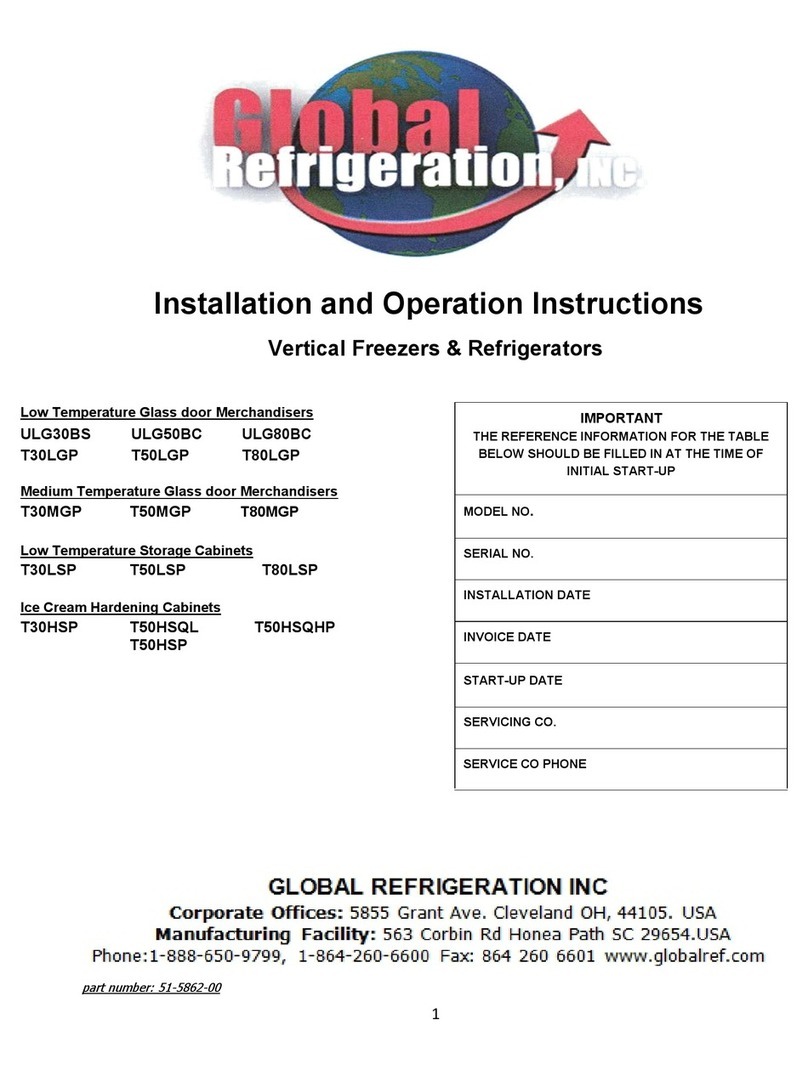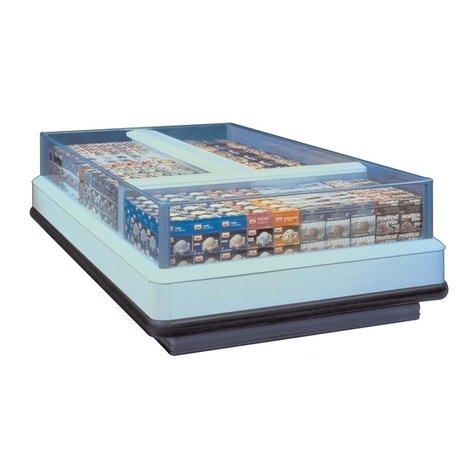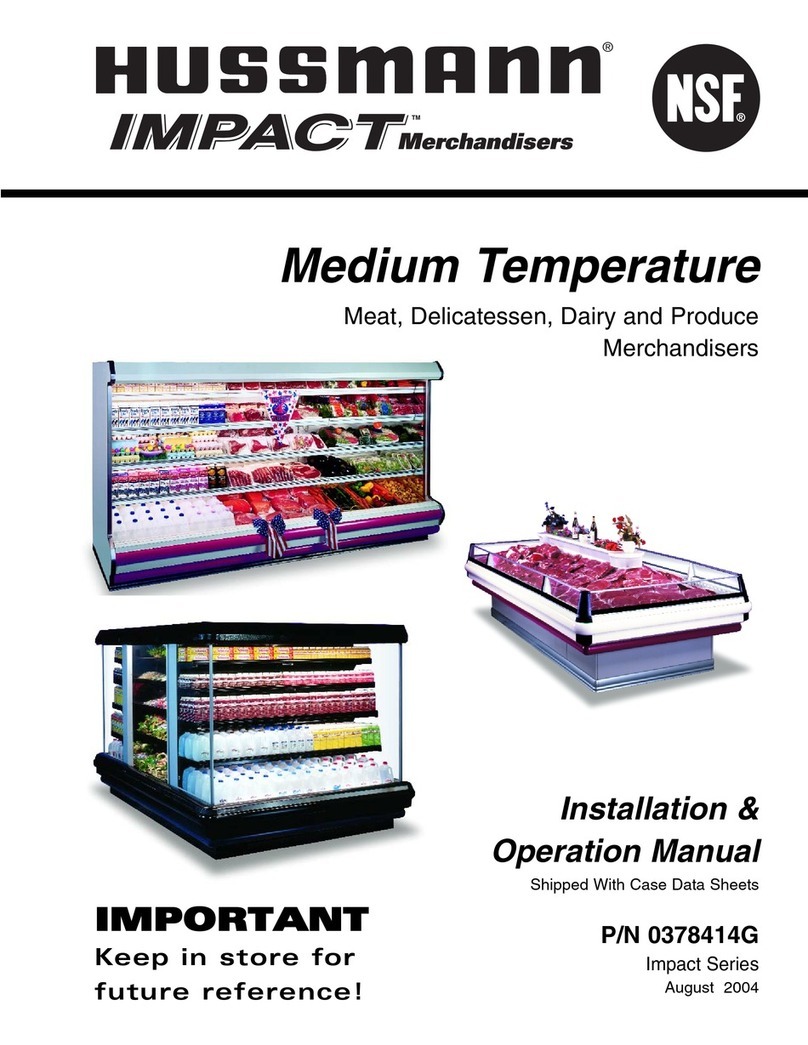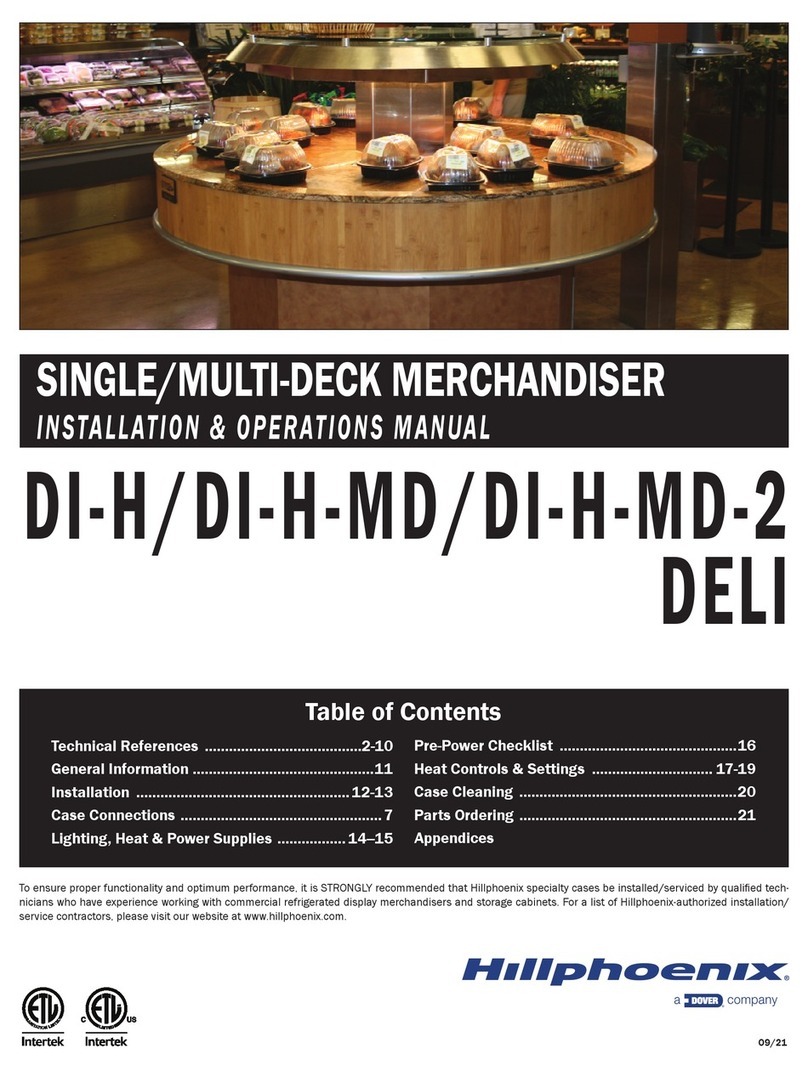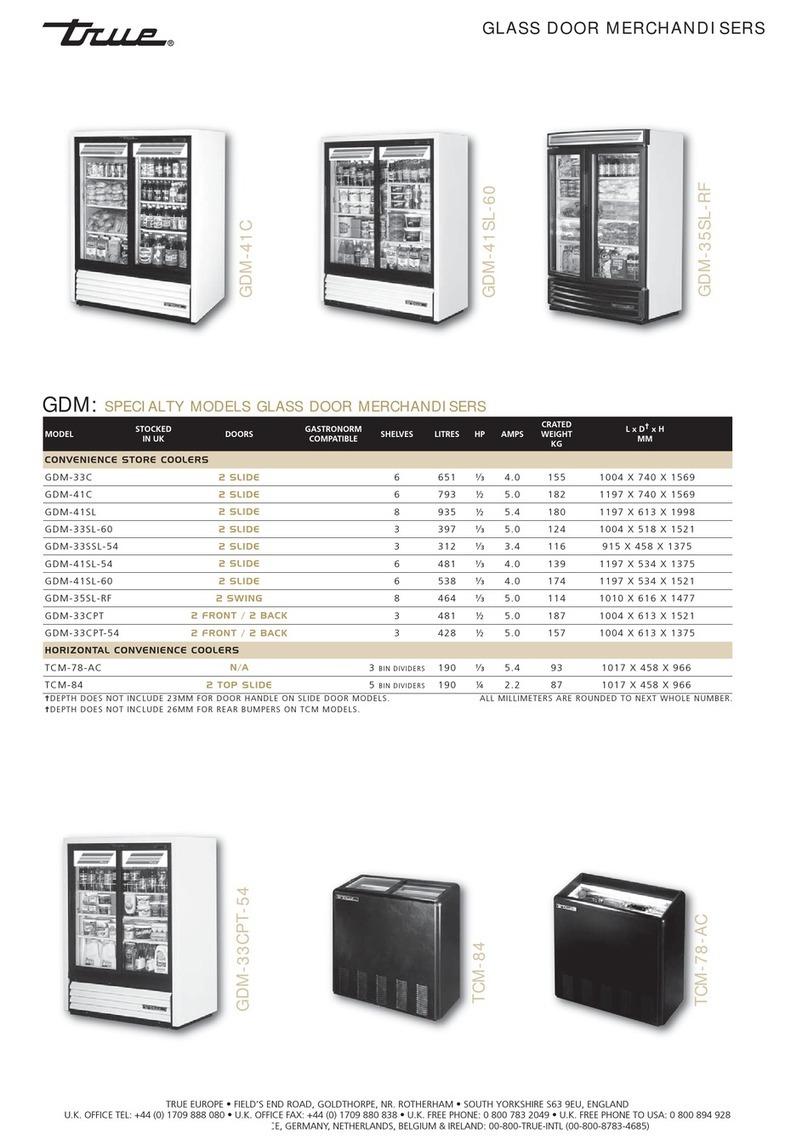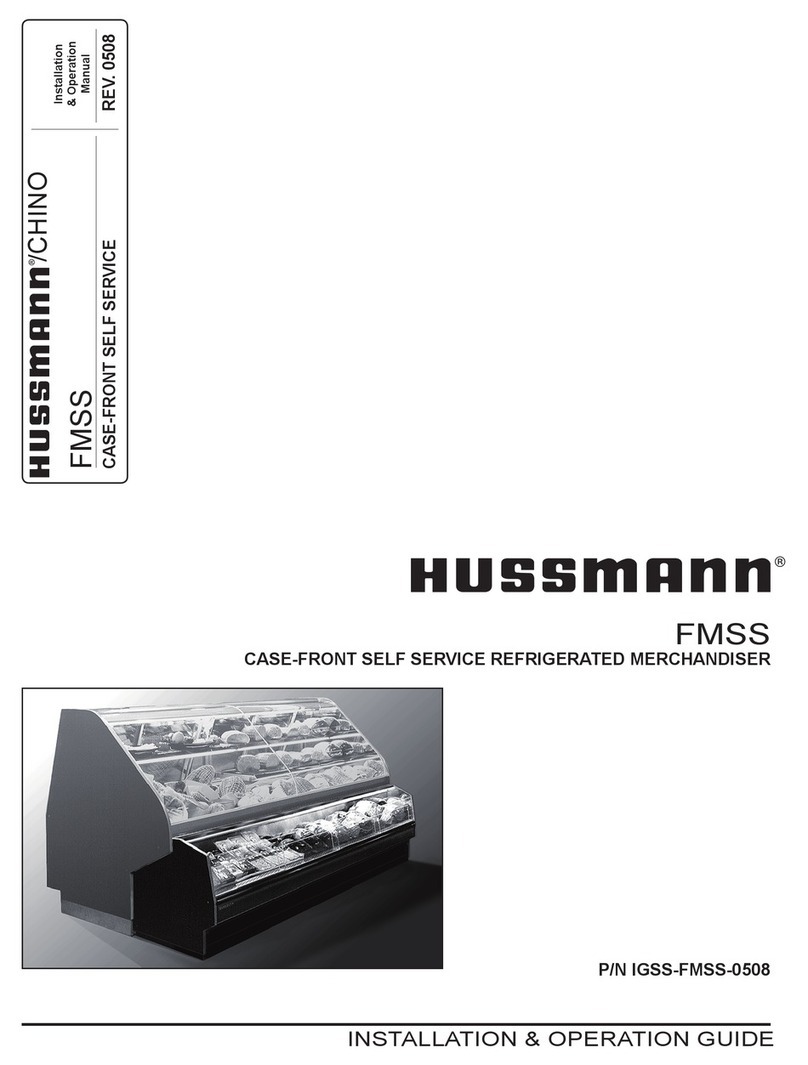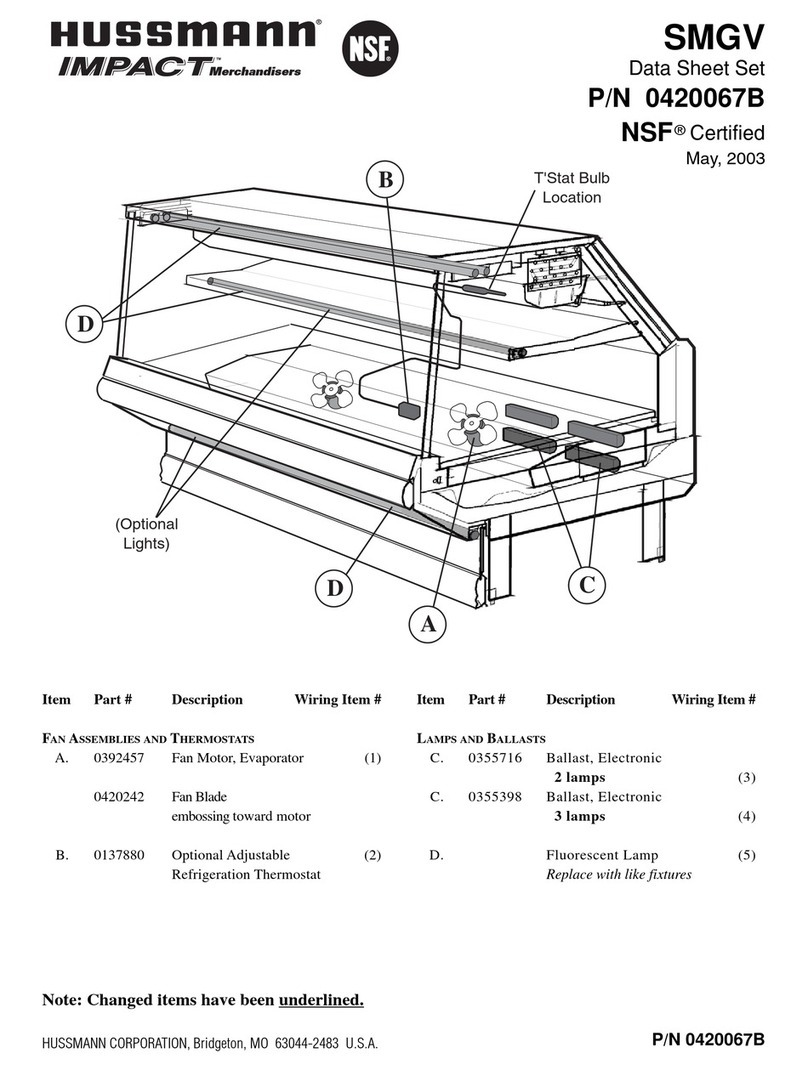Global Refrigeration ULG30 Owner's manual

Installation and Operation Instructions
Vertical Freezers & Refrigerators, with EVCO
Digital Control & R29 REFRIGERATION SYSTEM
Low Temperature Glass door Merchandisers
ULG3
ULG5
ULG8
T3 LGP
T5 LGP
T8 LGP
Medium Temperature Glass door Merchandisers
T3 MGP
T5 MGP
T8 MGP
T3 MSP T5 MSP T8 MSP
Low Temperature Storage Cabinets
T3 LSP
T5 LSP
T8 LSP
Ice Cream Hardening Cabinets
T3 HSP
T5 HSQL
T5 HSQHP
T5 HSP T5 HSHP
IMPORTANT
THE REFERENCE INFORMATION FOR THE TABLE
BELOW SHOULD BE FILLED IN AT THE TIME OF
INITIAL START-UP
MODEL NO
.
SERIAL NO.
INSTALLATION DATE
INVOICE DATE
START-UP DATE
SERVICE CO.
SERVICE CO PHONE
GLOBAL REFRIGERATION
563 Corbin Rd Honea Path SC 29654
888-65 -9799


ADDITIONAL INFORMATION OR TECHNICAL ASSISTANCE
For customer service or technical assistance, please call our
manufacturing facility toll free number:
1-888-650-9799
Our Customer Service Representatives and Engineers are willing to
assist you in any way possible. Office hours are from 8am to 5pm,
Monday-Friday (Eastern Standard Time)
****Copies of Installation and Maintenance Manual and for helpful videos, please visit
our web site at; www.globalref.com*****
___________________________________________________________________
Corporate Offices: 5855 Grant Avenue, Cleveland, OH 44105. USA
Manufacturing Facility: 563 Corbin Road, Honea Path, SC 29654. USA
Phone: 1.864.260.6600 Toll Free 1.888.650.9799 Fax 1-864-260-6601
Important information is contained in this manual
which should be retained in a convenient location for
future reference. Information in the manual is subject
to change without notice.


An Important Message for Installers and Operators
These instructions include information intended to assure correct installation, operation and trouble-free
service. Prior to attempting installation, service or operation, be certain of the following:
1. You have fully read and understood these instructions
2. You have the tools required and sufficient training to use them.
3.You have met all code, installation and application restrictions.
4. You are familiar with the function and operation of the unit.
5.That these instructions are followed exactly as given.
Inspect for Damage
This unit was packaged and inspected at the factory and
was in excellent condition at the time of shipment. The
transit company or others involved in it’s handling are
responsible for loss or damage that may have occurred
after the unit left the factory. Inspect the underside of the
cabinet and packaging for damage such as a forklift
might cause. Also, look for bent components that might
indicate that the unit has been dropped. Open any
cartons that appear to have damage and inspect the
contents. Always attempt to inspect the unit prior to the
departure of the delivery driver so that the driver can
detail the damage on the freight bill. If damage is found
after uncrating, immediately call the delivery carrier and
re uest an inspection. Most carriers re uire that
inspections be done within 15 days of delivery. Retain all
packaging and crating materials for damaged units until
the inspection is complete.
Locating the Cabinet
Select a location where the cabinet will not be exposed
to heat sources such as sun through windows, heating
vents, etc. Extension cords should be avoided, so a
receptacle of the proper type and current rating should
be within 6 feet of the unit’s location.
CLEARANCE REQUIREMENTS: Allow a minimum of
twelve (12) inches between the top of the cabinet
and ceiling and a minimum of two (2) inches
between the back of the cabinet and wall for proper
air circulation through the condensing unit.
Installing the Cabinet
(Models with Top Mounted Compressors)
Whenever possible, leave the crate skid on the cabinet
until it is moved close to the final position. If the cabinet
must me moved through a narrow doorway, it may be
necessary to remove the crate skid. Wood runners are
provided on the underside of the cabinet for ease in
sliding. The runners should be left attached to the
cabinet when the skid is removed and should remain
attached until after the legs are installed.
The cabinet can then be pushed around more easily
without scratching the floor. The runners also prevent
damage to the electrical receptacle and condensate pan
hardware on the cabinet bottom. After the cabinet has
been moved to the approximate final location, remove
the package containing the legs from the cabinet interior.
Tape the doors to prevent accidental opening while
handling. Raise the sides of the cabinet high enough to
mount the legs at the locations provided on the bottom of
the cabinet. Level the cabinet by means of the leg
adjustments. The cabinet doors are self-closing, and the
cabinet must be level to operate properly.
Condensation Pan
(Models with Top Mounted Compressors)
The condensate pan assembly mounts in the “track” pro-
vided on the underside of the cabinet. The pan assembly
must be pushed in from the front of the cabinet far
enough to be positioned under the condensate drain
tube on the backside of the cabinet.
NOTE: THERE IS A PROTECTIVE COVER OVER THE
ELECTRICAL RECEPTACLE ON THE CABINET BOT-
TOM WHICH MUST BE REMOVED AND DISCARDED
PRIOR TO THE CONDENSATE PAN INSTALLATION.
The pan assembly must be secured by a #10-32 thumb
screw and is designed to prevent accidental unplugging
of the pan supply cord. The pan must be in the correct
position to insert the thumb screw. Shut off the power
supply before plugging in pan supply cord.
Installing the Cabinet
(Models with Bottom Mounted Compressors)
To remove the skid the skid mounting clips, located
behind the front griII must be removed.

Once the front clips are removed the cabinet can be slid
forward to clear the rear mounting clips. After removing
the skid, move the cabinet into location. Make sure the
cabinet is level so that the self-closing doors operate
properly.
Electrical Requirements
Check the electrical rating plate on the cabinet to be
sure the one re uired matches your re uirements.
Check voltage and amp draw on the serial plate to
determine proper fuse and wire size.
CAUTION:
All cabinets must have a grounded
supply receptacle. The cord provided must be used
only with its ground pin intact.
It is recommended that a separate supply circuit be run
for each cabinet to prevent the possibility of another
appliance blowing a fuse, causing subse uent loss of
product. Caution: The insulated space of this cabinet is
sealed to maintain peak efficiency. Holes drilled in the
cabinet may destroy that seal and damage electrical
wiring located in the insulated space.
CAUTION
:
The insulated space of this cabinet is
sealed to maintain peak efficiency. Holes drilled in
the cabinet may destroy that seal or damage
electrical wiring located in the insulated space.
DAMAGED ELECTRICAL WIRING OR WET
INSULATION CAUSED BY DRILLING WILL VOID
THE WARRANTY.
N.S.F. Required Installation Procedures
Shelf Brackets:
To comply with NSF re uirements, the shelves and
their brackets must be removable without the use of a
tool. At the time of initial installation, all shelf bracket
screws should be loosened with a tool and re-tightened
“hand tight”.
Floor sealing of cabinets without legs or casters:
(bottom mount cabinets only)
1) Remove front grill.
2) Seal around entire outside perimeter of cabinet
(except sides, if against wall) with an N.S.F.
approved sealant (GE-802, DOW-732).
3) Sealed joint should be smooth and easily cleanable.
4) Replace front grill.
Cabinet Start-up
Once the cabinet has been located in its permanent
location and the proper power and grounding has been
provided, the following items must be checked or
completed:
a.)
Cut and remove the compressor shipping strap
(where supplied) so the compressor “floats” freely.
b.)
Check for traces of oil on the compressor pan which
could mean a broken or leaking refrigeration line.-
UNDER NO CIRCUMSTANCE SHOULD THE
COMPRESSOR BE STARTED WHEN OIL IS
PRESENT UNTIL AFTER AN INSPECTION BY A
SERVICE TECHNICIAN.
c.)
INSPECT FACTORY WIRING FOR TERMINALS
THAT MIGHT HAVE LOOSENED DURING
SHIPPING TIGHTEN ALL SCREW TYPE
TERMINALS
d.)
Check the refrigeration lines to see that they are
'free" and no damage was done during shipping.
e.) Check that the fan blade(s) rotate freely.
f.)
Turn on the main power switch. Once the compres-
sor starts, the voltage should be checked at the
compressor terminals to determine if there is
proper voltage to the compressor. The voltage
should not exceed the 10% above or below the
rated compressor voltage. EXAMPLE: If the supply
voltage reads 115 volts with the unit off and it
drops below 10 volts once the compressor is
running, it may indicate that the supply wiring is
insufficient.

g.)
Make sure that the drain line has not been
dislodged or broken during shipping and that the
drain trap terminates properly in the condensate
pan or floor drain. (See Condensate Pan on Top
Mounted Compressor.)
h.)
Listen for any unusual noise such as lines vibrating,
fan blades hitting etc. Correct problem by
tightening screws, slightly bending tubing, etc.
i.)
Check proper tension on doors. (See Door Closer
Adjustment.)
Thermostat Settings
The refrigerator or freezer is shipped from the factory
with a thermostat setting of approximately the mid-point
of the operating range. Final thermostat setting must be
made in the field. Allow the cabinet to operate until the
compressor cycles on the thermostat.
The normal operating temperature ranges are:
42°F to 36°F for Refrigerator models;
20°F to -20°F for Display freezers;
0°F to -20°F for Storage freezers;
0°F to -30°F (or-40°)F for Hardening freezers;
See the section “Instructions For The Digital Control”
located later in this manual..
IMPORTANT: DO NOT OPERATE MEDUIM
TEMPERATURE CABINETS (REFRIGERATORS)
BELOW 32°F
Door Adjustment & Removal
Glass doors use an internal torsion rod to adjust closing
tension; solid doors use a cam in the hinges to control
closing.
Door Closer Adjustment
( Glass Doors)
Loosen Nut "A" and turn the s uare shaft to increase or
decrease the torsion rod tension to the desired tor ue.
Turn the s uare shaft towards door handle to increase
tor ue; then tighten
Nut
"A" to lock.
The door should be set to swing smoothly and should
not slam. Also the door should self-close when opened
only a couple. of inches
Removing Outer Doors
(Solid Doors)
If the assembled cabinet is too wide to move through narrow
doorways, the cabinet doors can be removed as follows:
1 )Open the door 180°and support the outer edge.
Remove the screws in the upper hinge at the cabinet,
leaving the hinge attached to the door. Lift and
remove from lower hinge pin. CAUTION: The upper
hinge cam is under significant spring tension. Leave
the hinge in the open position (KEEP HANDS
CLEAR)
2) After legs are on and the cabinet is in final position,
set the doors back on the hinge pins.
Energy Conservation Measures
These cabinets are designed for efficiency with heavy
foam insulation. However, there are things that the user
can do to maintain the cabinet in operating condition.
1) Do not operate the cabinet any colder than necessary
to maintain safe, product storage temperatures.
2) Make sure the cabinet is located to prevent direct
exposure to sunlight, air ducts, etc.
3) Keep the doors closed except for normal use. Inspect
the doors often to see that they self-close and that the
4) Do not overstock the product in the cabinet which will
block normal air flow.
5)
Keep the condenser coil clean. The coils should be
inspected at least twice a year.
6) Have at least annual inspections by a ualified service
company to see that the fan motors are functioning
properly and that the refrigerant charge is correct.
7) These cabinets operate more efficiently in a
cooler ambient than in a "hot ambient. Try to
maintain an ambient of 7 -75°F (23.9°C) and 5 -
55% humidity level for maximum efficiency.
ROUTINE MAINTENANCE
Cleaning the Interior
Wash the inside surface of the storage one tablespoon
of baking soda per uart of water.) Rinse thoroughly
with clean, warm water and wipe dry. The procedure
can also be used for cleaning the door gasket. Be sure
the power is turned off before cleaning.
Cleaning the Exterior
Wipe the cabinet exterior occasionally with a cloth
dampened in mild detergent water, rinse and wipe dry
with a soft cloth. Do not use abrasive or caustic
cleaners or scouring pads.
Cleaning the Condenser
Clean the condenser periodically by brushing the coil with
a soft brush and/or using a vacuum cleaner with a brush
attachment. Be sure that the power is disconnected

before cleaning. The condenser fan must be off while
cleaning for safety and to prevent loosened debris from
being drawn further into the coil. Be sure that dirt, dust and
collection of other debris does not build up to a point where
air circulation through the condenser is restricted.
Cleaning the Condensate Pan (Heated)
Caution: De-energize the unit prior to cleaning
heated condensate pans by unplugging the unit
Caution: The heating element used to vaporize the
water in the pan can get quite hot. After unplugging
the unit, allow 1 minutes for it to cool prior to
removing the pan.
The pan is located on the bottom of the cabinet.
Removing the screw that holds the cover over the
electrical plug, unplug the condensate heater and slide
the pan forward to remove it from the cabinet.
Remove and clean all deposits that have built up in the
pan. Take care when replacing the pan to insure that it
is properly placed under the evaporator drain tube that
empties into it. High traffic or humidity may increase the
re uirements for servicing this pan.

Control overview, Parameters and Theory of Operation
This unit is e uipped with a sophisticated, microprocessor based, digital electronic control. All of the temperature and
defrost functions are controlled by use of a subset of a broad range of the control’s capabilities. Global Refrigeration has
preconfigured this control for optimal performance. It is highly recommended that the parameters (other than set point
temperature) be left at their Global Refrigeration factory settings. In the event of a control failure, Global Refrigeration
recommends that the replacement control be sourced from us, as our factory replacement part will be preconfigured for
the specific model re uired.
.
CAUTION: It is essential that control replacement is only done by trained service professionals; non- standard
program parameters may result in serious machine failures and may void the unit or compressor warranty.
Theory of operation: Digital controls for Global freezers are e uipped with two temperature sensors; a cavity sensor
and a defrost sensor. It is configured for a time interval initiated / temperature terminated defrost cycle.
The evaporator fan(s) are configured for continuous operation with the exception that they will de-energize via the
controller’s fan relay during defrost or by the door switch(s) if a door is opened. As temperature rises in the cabinet up to
the set point temperature plus the differential, the compressor control relay will energize, powering the compressor
contactor and the compressor will run. As the temperature falls to the set point, the control will de-energize the
compressor relay. After 12 hours of operation (or other interval specified) the unit will initiate a defrost cycle . Upon
initiation of the of the defrost cycle, the compressor and evaporator fans will de-energize. The control will close the
defrost heater relay and the defrost heater will start heating the bottom of the evaporator coil. As frost melts away, the
temperature of the evaporator outlet tube, (where the defrost temperature sensor is located) will warm. When the
defrost sensor rises above it’s set point temperature of 35°F the defrost heaters will de-energize and the compressor will
be energized. If the defrost sensor fails to reach it’s stop temperature the control will invoke a timed termination after
30minutes of defrost time. Note that the evaporator fans will not resume operation at the same time as the compressor.
The evaporator fans will remain off for 10 minutes or until the defrost sensor’s temperature declines to 20°F; whichever
comes first.
SEE
NEXT PAGE
FOR EVCO DIGITAL CONTROL
INSTRUCTIONS


USER SERVICE DIAGNOSTICS:
Closer spring needs adjustment
See section
on Door Adjustment
in Start
-
up
section
Door fail to self close
Cabinet Un
-
level
Level cabinet using leg adjustment or shims
(Glass doors only)
Door closer spring broken, gasket failure
Request service, provide service agent ith
unit’s model &
serial no. for parts requisition
Confirm temperature setting of electronic
See instructions on
Changing the Set point
control
Door gaskets loose, torn, or ineffective due
Clean or de
-
ice as needed or request service for
to ice or
residue
gasket replacement
Cabinet environment too arm
Insure that room is belo 80°, meets minimum
clearance requirements and unit is not subject to
heat from adjacent appliances.
Dirty Condenser coil
See
Routine
Maintenance
for coil cleaning
Cabinet will not hold
instructions
temperature and / or runs
continuously
Evaporator “Frost bound” (incomplete
Attempt one or t o manual defrost cycles to see
defrost cycles)
if normal
operation resumes. If not, high
humidity/door cycles may require additional
defrost periods. Failure to defrost may also
indicate bad heater, door gasket, control or
setting; requiring professional service.
Refrigeration system capacity lo due to
Professional service required; provide service
defective component or refrigerant charge
agent ith unit’s model & serial no. at time of
service request
Compressor starting intermittently or
Professional service required;
shutting off by overload protector
Supply circuit inadequate, defective compr. start
components, crank case regulator inoperative
Cabinet too cold
-
Thermostat incorrectly set
-
See instructions on
Changing the Set point
-
Defective sensor
-
Sensor: Professional service required
Cabinet will not cool at all,
Probable service level problem
Request service, provide service agent ith
but lights, fans and/or
unit’s model & serial no. for parts requisition
control appear to function
Cabinet will not cool at all,
Probable loss of po er
-
Check to see that unit is plugged in,
-
Check supply circuit po er (fuse or circuit
controls, lights and fans
all
breaker good).
inoperative
-
Po er s itch on unit is ON
Light s itch off, blo n fuse.
-
Turn on s itch, glass door models have a light
All lights inoperative.
s itch inside the cabinet on the lamp channel.
-
All
models have a fuse located in the electrical
enclosure (caution: fuse replacement may
require professional service)
LED fixture poorly seated in socket LED
-
Reinstall fixture in sockets.
Some lights inoperative
light fixture
defective,
-
Defective: Request service, provide service
agent ith unit’s model & serial no. for parts
requisition
-
Compressor shipping strap still installed
-
Cut & remove strap.
-
Unit unlevel or on irregular surface,
-
Level or
support unit, silicon seal base to floor
Unit Noisy
-
Service level problems: Refrigerant flood
-
Request professional service
back, fan blade contact, incidental
component contact, compressor feet too
tight, loose fasteners, defective
compressor
or components

This manual suits for next models
19
Table of contents
Other Global Refrigeration Merchandiser manuals
Popular Merchandiser manuals by other brands
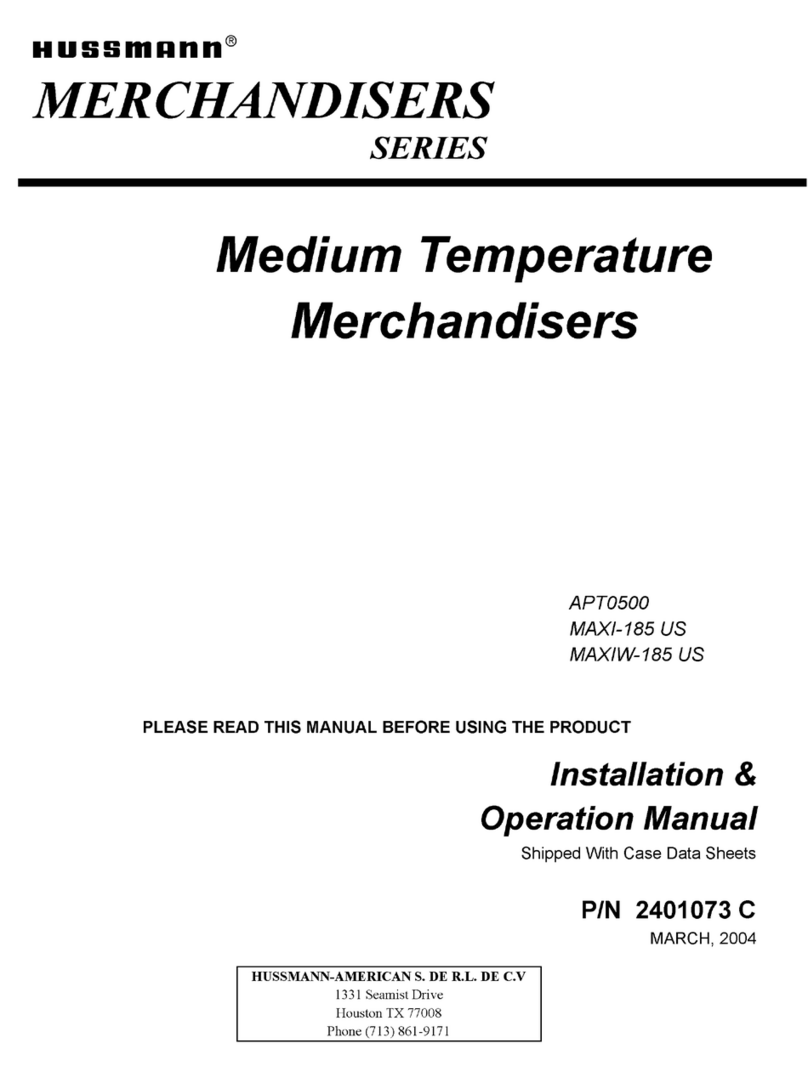
Hussmann
Hussmann APT0500 Installation & operation manual
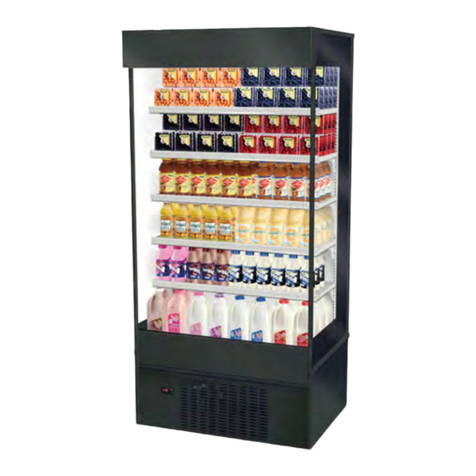
Hussmann
Hussmann microSC MDN-BA Installation & operation manual
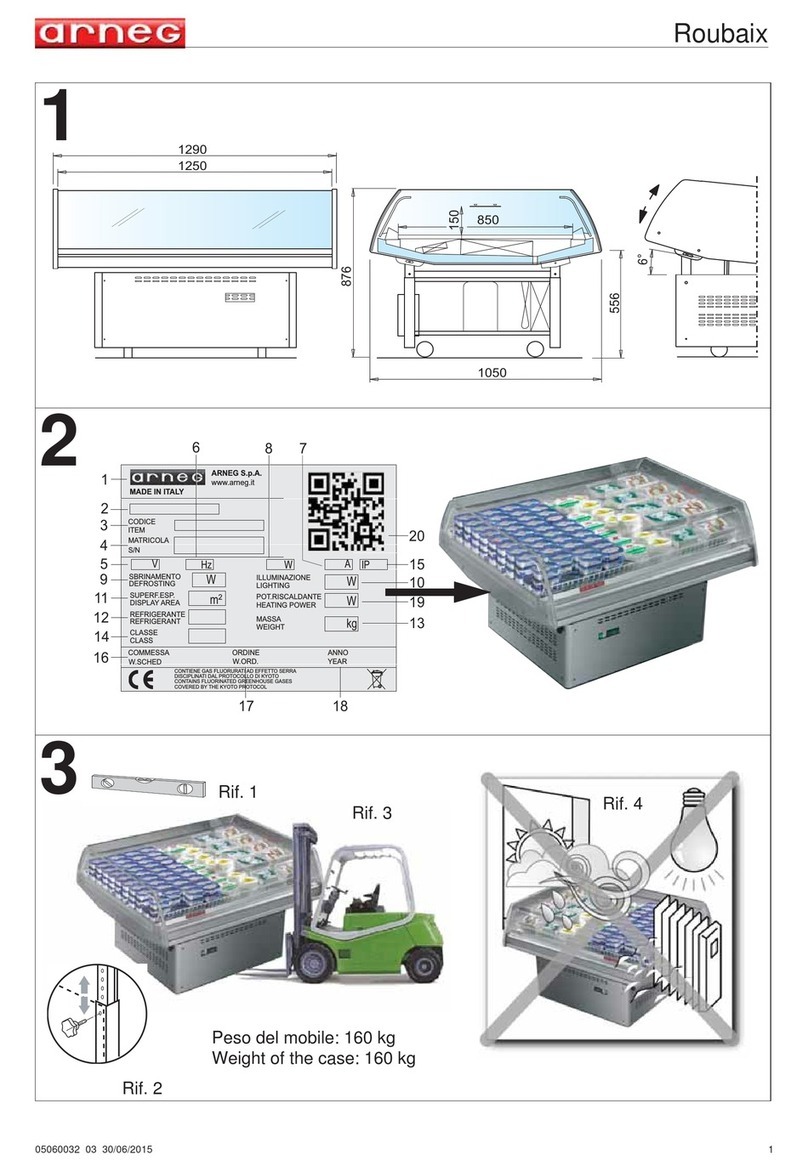
Arneg
Arneg ROUBAIX 085 MAXI Installation and use manual

Hussmann
Hussmann RI1 Installation and operation manual
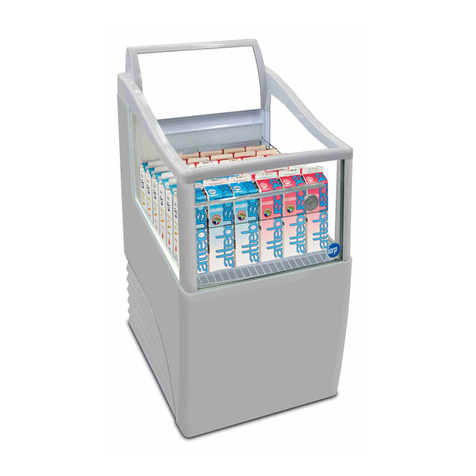
EPTA
EPTA iarp JAZZ M Use and maintenance
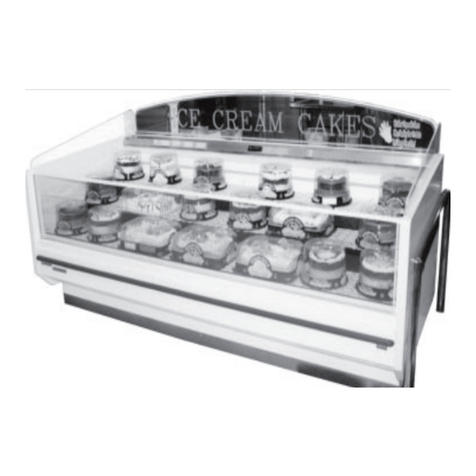
Hussmann
Hussmann SCSS Technical data sheet

Hussmann
Hussmann Impact C2-E quick reference
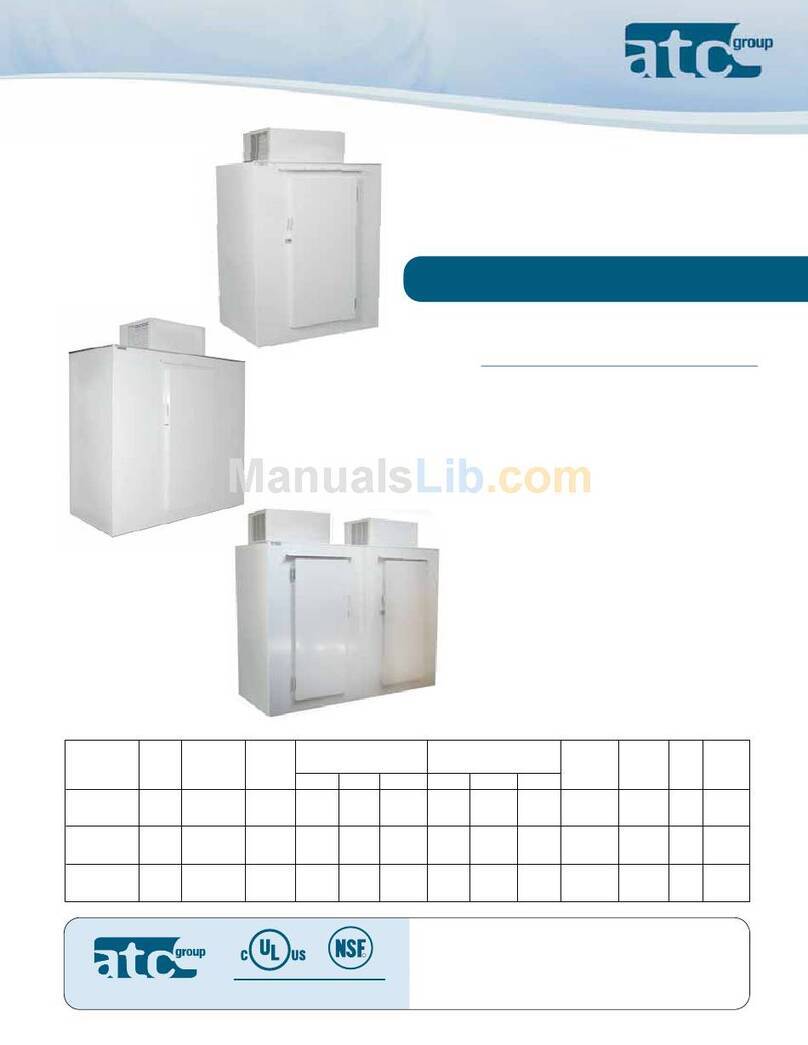
ATC Group
ATC Group Ice Merchandisers CBH-100 product manual

Hussmann
Hussmann SHVSS-C Installation and operation guide
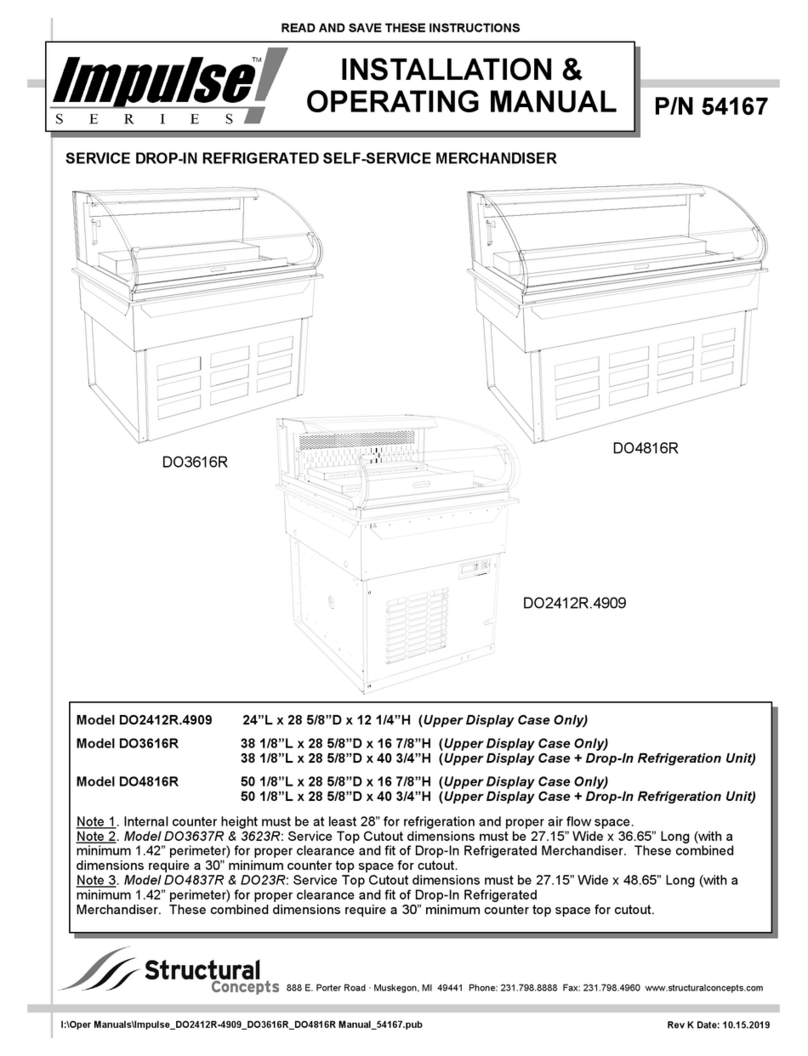
Impulse
Impulse DO3616R Installation & operating manual
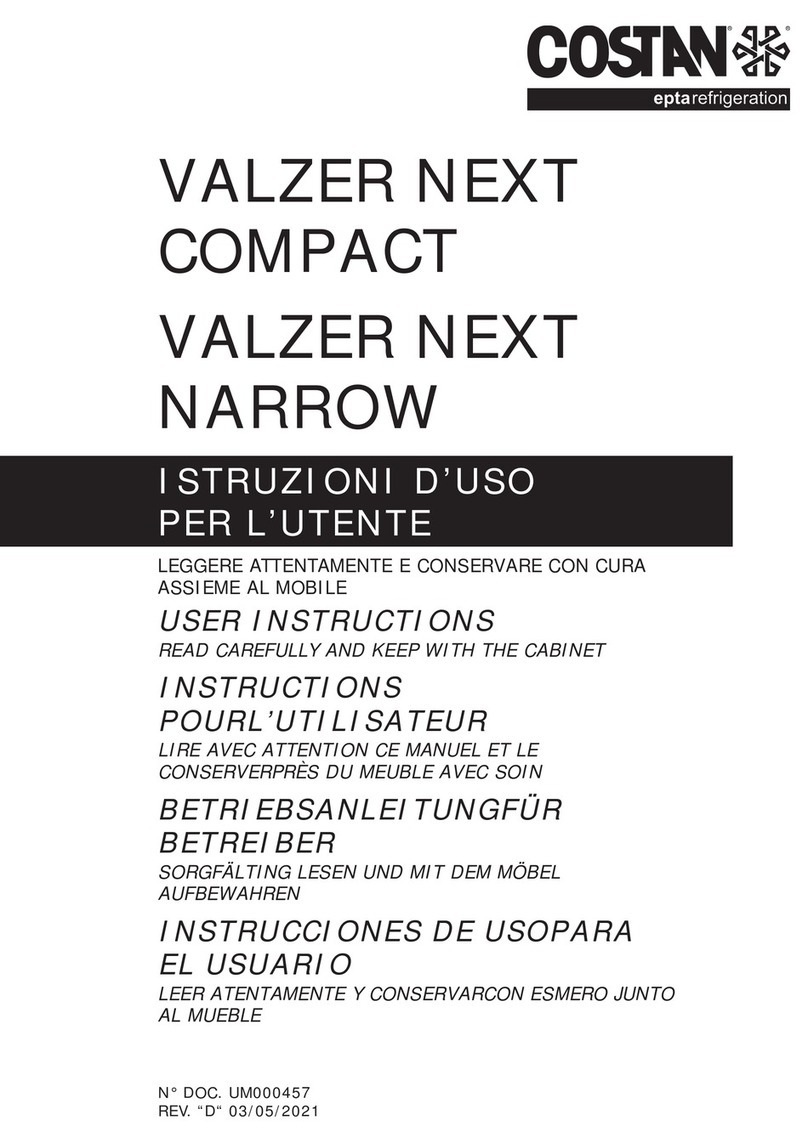
EPTA
EPTA Costan VALZER NEXT COMPACT User instructions
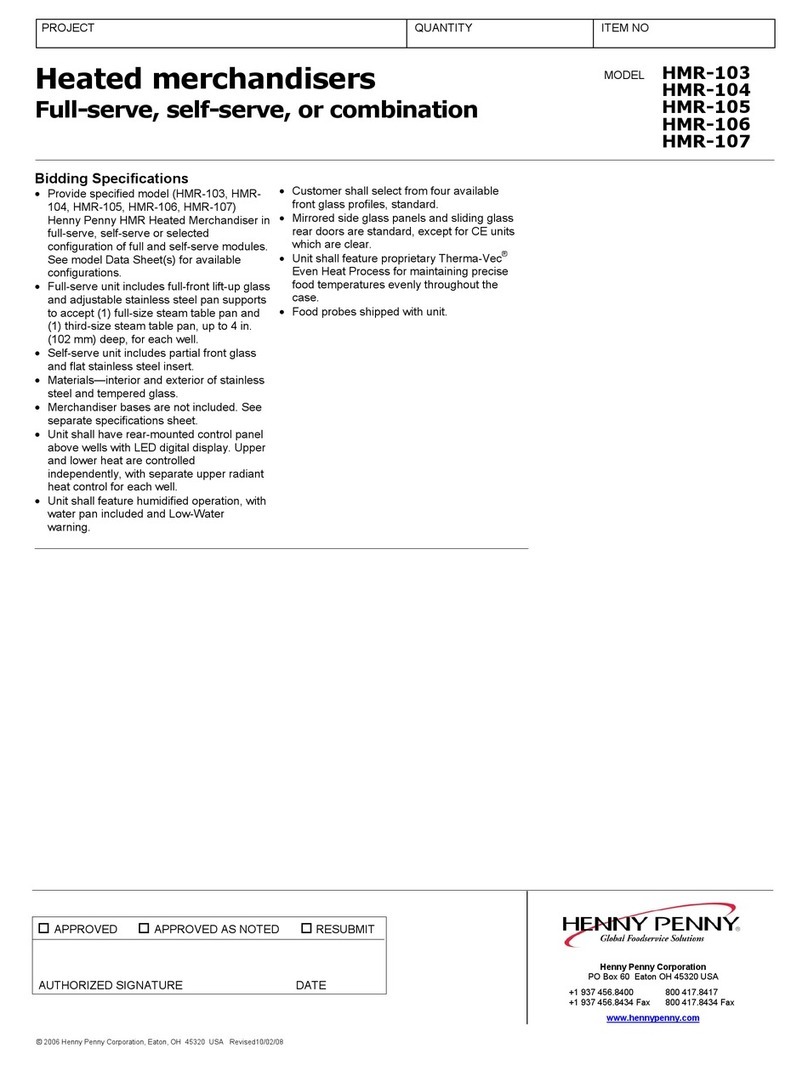
Henny Penny
Henny Penny HMR-103 Specifications
